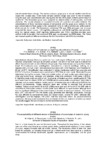Please use this identifier to cite or link to this item:
http://www.alice.cnptia.embrapa.br/alice/handle/doc/661973| Title: | Effect of pre-treatment on açaí pulp microfiltration process. |
| Authors: | MONTEIRO, F. S.  GOMES, F. S.   MATTIETTO, R. A.   CABRAL, L. M. C.   MATTA, V. M.   |
| Affiliation: | F. S. MONTEIRO, UFRRJ; F. S. GOMES, UFRRJ; RAFAELLA DE ANDRADE MATTIETTO, CPATU; LOURDES MARIA CORREA CABRAL, CTAA; VIRGINIA MARTINS DA MATTA, CTAA. |
| Date Issued: | 2009 |
| Citation: | In: EUROPEAN FEDERATION OF FOOD SCIENCE AND TECHNOLOGY CONFERENCE, 2009, Budapest. New challenges in food preservation: processing: safety: sustainability. Wageningen: EFFoST, 2009. 1 CD-ROM. Ref. P132. |
| Description: | Açaí (Euterpe oleracea Mart.) is a palm tree from north region of Brazil. Its small fruit is rich in bioactive compounds making it an attractive product. The aim of this work was to evaluate the effect of pre-treatments on microfiltration of açaí pulp. Raw material was acaí pulp from Belém, Brazil. Pre-treatments were centrifugation, conducted in a basket centrifuge; refining, in a depulper with a 0.5 ?m mesh; and enzymatic hydrolysis with DSM Rapidase and Picantase for 30 min at 35oC. Microfiltration was conducted in tubular membranes with 0.1?m pore size and 0.022m2 of surface. Processes were carried out at 35oC/3bar in batch mode. Permeate flux was determined during the process. Total and soluble solids, pH and acidity were determined on initial and treated pulp, permeate and retentate. Initial pulp contained 13.89 (w/w), 2.85oBrix, 0.19g/100g (malic acid) and 4.93 of pH. Total solids of treated pulp from centrifugation (5.71%) were lower than the others (13.83 and 13.84%) which consequently caused lower total solids in retentate and permeate fractions. Acidity and pH of treated pulp were different (p<0.05) for the different pre-treatments. Similar behaviors were also verified to retentate and permeate fractions. Values varied from 0.10 to 0.29 g/100g malic acid and pH from 4.17 to 4.98, with no correlation to total solids content. Soluble solids were different for each fraction although there was no significant difference in the same fraction in function of used pre-treatment. The values were 2.87, 1.63 and 4.77oBrix for treated pulp, permeate and retentate, respectively. Average flux was affected by pre-treatment being the lowest values, around 70 L/hm2, obtained after centrifugation and the highest, 110 L/hm2, with the enzymatic action. As physical-chemical parameters did not present a behavior that contributes for the pre-treatment selection, permeate flux results suggest the use of enzyme as the recommended option. |
| Thesagro: | Enzima Fruta Tropical Suco de Fruta |
| Keywords: | Polpa de açaí Tecnologia de membrana |
| Type of Material: | Resumo em anais e proceedings |
| Access: | openAccess |
| Appears in Collections: | Resumo em anais de congresso (CTAA)  |
Files in This Item:
| File | Description | Size | Format | |
|---|---|---|---|---|
| 2009224.pdf | 116.31 kB | Adobe PDF |  View/Open |









